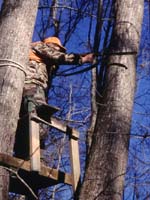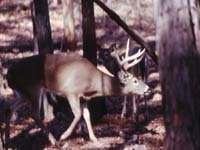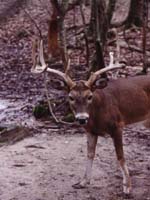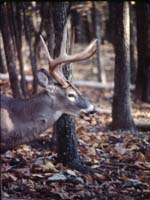
|
Features
|
|
|
|
Books
|
|
|
|
Fun & Games
|
|
|
|
Contact Us
|
|
|
John's Journal... Entry 64, Day 1
The Importance of Knowing When to Shoot
 EDITOR'S
NOTE: To know when to shoot, you must become a student of deer and
their behavior, pay attention to the deer you're hunting and what they're
doing and understand the moods and habits of deer.
EDITOR'S
NOTE: To know when to shoot, you must become a student of deer and
their behavior, pay attention to the deer you're hunting and what they're
doing and understand the moods and habits of deer.
The .30-06 went off with a resounding pop that echoed through the swamp. Immediately, the 4-point buck jumped backwards like a coiled spring released after compression. As quickly as the deer jumped, the hunter reloaded his gun and prepared for the next shot, while watching the white tail of the buck flagging away from him.
The deer only ran about 20 yards before stopping. Since the hunter had his .30-06 ready, he could study the animal. The buck had his head up and looked around but not into the cover where the hunter stood. The buck studied the forest floor, and his head went up and down. He stuck his neck straight out -- attempting to test the wind to see if any trace of odor remained that might let him know what had caused the crashing sound under his belly.
 When
the buck could pinpoint no danger, slowly and carefully, one foot at a
time, he walked, stopping to look around, stick his neck out and test
the air every five or six steps. The hunter aimed his gun. As the buck
approached, he stretched out his neck. Finally the hunter sighted just
behind the buck with his neck extended and a little low on the buck's
front shoulder.
When
the buck could pinpoint no danger, slowly and carefully, one foot at a
time, he walked, stopping to look around, stick his neck out and test
the air every five or six steps. The hunter aimed his gun. As the buck
approached, he stretched out his neck. Finally the hunter sighted just
behind the buck with his neck extended and a little low on the buck's
front shoulder.
The deer bolted and ran for about 20 yards before vanishing into a cane thicket. The hunter listened as the buck crashed through the cane. Then the hunter heard nothing but silence and next a low thud. As he waited to recover his buck, he thought about how the deer had approached and why he'd gotten a second shot.
The buck had come in to the white oak acorns to feed -- very calmly and never suspecting danger -- in a region with little or no hunting pressure. This 2 1/2-year-old buck probably never had seen a hunter before.
 When
the hunter shot his first bullet, the deer instinctively jumped away from
it. Because the deer had felt very little hunting pressure, he was more
curious than frightened. The buck's calmness convinced the hunter that
he might get off a second shot.
When
the hunter shot his first bullet, the deer instinctively jumped away from
it. Because the deer had felt very little hunting pressure, he was more
curious than frightened. The buck's calmness convinced the hunter that
he might get off a second shot.
A deer often will tell you when to take the shot. If the buck hasn't become spooked and comes in calmly, you can take the shot whenever you wish. But with a nervous buck, you must have yourself ready to take the shot when the deer presents it.
 If
you can read the body language of deer, often you can anticipate that
second shot and prepare for it if you miss your first shot. Most hunters
realize that understanding a buck's body language means the difference
in whether or not you have success when hunting. Knowing the emotional
level of the deer will tell you if you should shoot, what shot you should
take, whether or not you'll get a second shot and how much you can move
through the cover. Many times we fail to connect with bucks because we
hurry our shots, believing if we don't shoot when we see the opportunity
for any shot that we won't have the chance to take a shot. However, if
we analyze the body language of the deer, often we can wait for a better
shot or the best shot.
If
you can read the body language of deer, often you can anticipate that
second shot and prepare for it if you miss your first shot. Most hunters
realize that understanding a buck's body language means the difference
in whether or not you have success when hunting. Knowing the emotional
level of the deer will tell you if you should shoot, what shot you should
take, whether or not you'll get a second shot and how much you can move
through the cover. Many times we fail to connect with bucks because we
hurry our shots, believing if we don't shoot when we see the opportunity
for any shot that we won't have the chance to take a shot. However, if
we analyze the body language of the deer, often we can wait for a better
shot or the best shot.
Tomorrow: The Mood of the Deer Will Tell You When to Take the Shot
Check back each day this week for more about When to Shoot ...
Day 1 -The Importance of
Knowing When to Shoot
Day 2 -The Mood of the Deer Will Tell You
When to Take the Shot
Day 3 -Nervously Feeding Deer
Day 4 -Stomping Deer, Bristled-Up Bucks,
Running Bucks and Calm Deer
Day 5 -Paying Attention to Deer to Know When
to Shoot